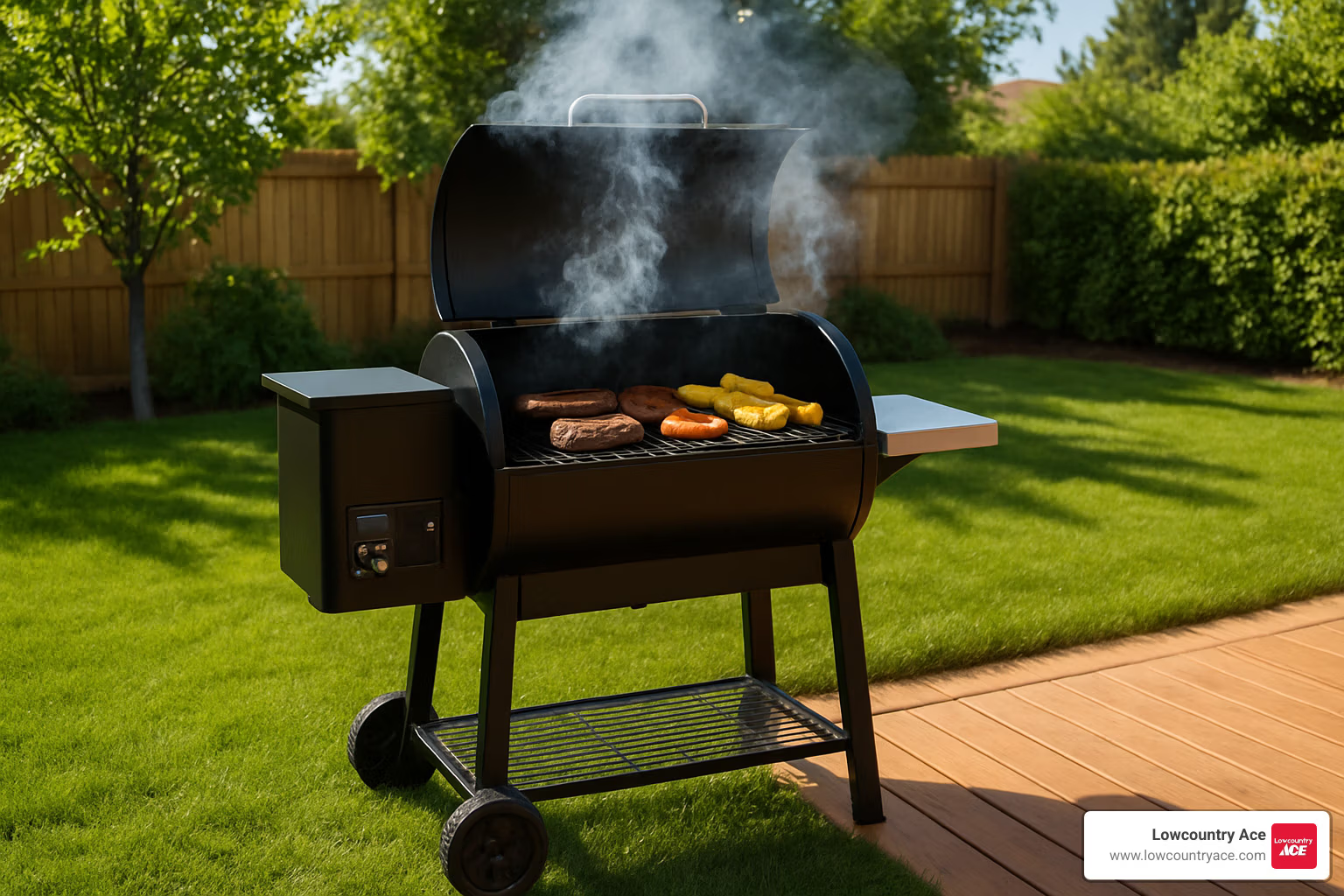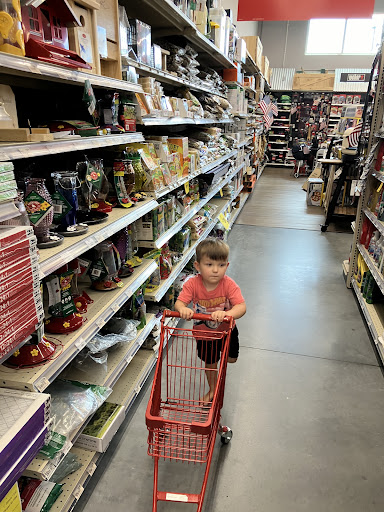Wood Pellet Barbeque Grills: 10 Best Powerful Picks 2025
The Complete Guide to Wood Pellet Barbeque Grills
Looking for the perfect wood pellet barbeque grills for your backyard cooking trips? Here’s what you need to know:
- Temperature Range: Most pellet grills operate between 150°F to 500°F, allowing for both low-and-slow smoking and high-heat searing
- Versatility: All-in-one outdoor cookers that can grill, smoke, bake, roast, braise, and barbeque
- Price Range: Typically between $349 to $3,300, with average models around $1,000
- Cooking Space: Up to 1,600 square inches on larger models
- Eco-Friendly: Pellet smokers have the lowest carbon footprint among all grill types
Wood pellet barbeque grills are revolutionizing backyard cooking by combining the authentic smoky flavor of traditional BBQ with the convenience of modern technology. Unlike their charcoal or gas counterparts, pellet grills use compressed hardwood pellets that are automatically fed into a fire pot, creating consistent heat and real wood-fired flavor with minimal effort.
What makes these grills stand out is their “set it and forget it” functionality. With digital temperature controls and automated pellet feeding systems, you can maintain precise cooking temperatures without constantly monitoring your grill. This means more time enjoying your guests and less time babysitting your food.
The helpful team at Lowcountry Ace has been guiding homeowners through the wood pellet grill revolution for years, helping countless customers find how these versatile cookers can transform ordinary backyard gatherings into extraordinary culinary experiences.
Wood pellet barbeque grills word list:
– outdoor wood cooking grills
– outdoor wood smoker
– wood chips for smokers
How Wood Pellet Grills Work & Why They’re Game-Changers
There’s something magical happening in backyards across Charleston, from James Island to Folly Beach. Wood pellet barbeque grills are changing everyday cooks into neighborhood BBQ legends—and for good reason!
At their heart, pellet grills combine old-school wood-fired flavor with smart technology that makes grilling almost foolproof. When you load hardwood pellets into the hopper, a clever auger-feed system (think of it as a mechanical screw) delivers just the right amount of pellets to the fire pot. An electric hot rod ignites them, while a combustion fan circulates air to create the perfect flame.
What really sets these grills apart is the digital controller—the mastermind that maintains your exact temperature setting whether you’re smoking ribs at 225°F or searing steaks at 450°F. It’s like having a BBQ assistant who never takes a break!
The fan-forced convection cooking system ensures heat circulates evenly throughout the grill, eliminating those frustrating hot spots that can ruin a perfectly good cookout. This consistent cooking environment is nearly impossible to achieve with traditional grills.
And here’s something that might surprise you: according to peer-reviewed research, pellet grills have the lowest carbon footprint among all grill types. So while you’re enjoying that perfectly smoked brisket, you can also feel good about making an environmentally responsible choice!
Wood Pellet Barbeque Grills vs Gas & Charcoal
When customers visit us at Lowcountry Ace, they often ask how pellet grills stack up against traditional options. The differences are significant:
Flavor depth is where pellet grills truly shine. Gas grills might be convenient, but they simply can’t match the authentic smoky goodness that comes from burning real hardwood. And while charcoal provides good flavor, pellet grills offer a cleaner, more consistent smoke that beautifully infuses your food.
The efficiency of pellet grills is remarkable—a 20-pound bag of pellets can provide up to 20 hours of cooking at lower temperatures. That beats constantly replacing propane tanks or adding more charcoal during long cooks.
As for ease-of-use, this is where pellet grills become true game-changers. Gas grills limit your flavor options, while charcoal requires constant attention. Pellet grills give you the best of both worlds—authentic wood-fired taste with “set it and forget it” convenience.
One of our Charleston customers summed it up perfectly: “I used to spend my entire cookout babysitting my charcoal grill. Now I actually get to enjoy time with my guests while my pellet grill does all the work.”
Pellet Grill Anatomy 101
Understanding the key parts of a wood pellet barbeque grill helps you make a smarter purchase and get the most from your investment:
The hopper is where you store your cooking fuel—hardwood pellets. Sizes typically range from 18 to 40 pounds, with larger hoppers allowing for extended cooking sessions without refilling.
The hot rod is an electric ignition system that lights the pellets when you start your grill—no matches or lighter fluid needed!
The combustion fan circulates air around the fire pot, maintaining optimal burning conditions while distributing heat and smoky flavor throughout the cooking chamber.
A heat shield (sometimes called a diffuser) sits above the fire pot to prevent direct flame contact with your food while ensuring heat spreads evenly across the cooking surface.
When customers visit Lowcountry Ace, the helpful team often demonstrates these components, showing how they work together to create the perfect cooking environment. Understanding this “under the hood” view helps explain why quality pellet grills are such worthwhile investments for serious outdoor cooking enthusiasts.
Whether you’re a BBQ novice or a seasoned pitmaster, wood pellet barbeque grills offer a remarkable blend of traditional flavor and modern convenience that’s hard to beat. They truly represent the next evolution in outdoor cooking—combining the best aspects of traditional methods with smart technology that makes consistently great results achievable for everyone.
Best Wood Pellet Barbeque Grills of 2024: Side-by-Side Comparison
Looking for the perfect wood pellet barbeque grill to lift your backyard cooking game? You’re not alone! Many of our Charleston neighbors stop by Lowcountry Ace with the same question. To help you steer the options, we’ve put together this friendly comparison of what’s available in 2024.
| Feature | Entry-Level | Mid-Range | Professional |
|---|---|---|---|
| Price Range | $349-$699 | $700-$1,499 | $1,500-$3,300 |
| Cooking Space | 450-650 sq. in. | 650-900 sq. in. | 900-1,600 sq. in. |
| Hopper Capacity | 15-20 lbs | 20-30 lbs | 30-40 lbs |
| Temperature Range | 180°F-450°F | 160°F-500°F | 150°F-700°F |
| Controller Type | Digital | Digital with Preset Programs | PID with WiFi |
| Construction | Powder-coated steel | Stainless/powder-coated mix | Full stainless steel |
| Warranty | 1-3 years | 3-5 years | 5-10 years |
| Smart Features | Basic temperature display | Bluetooth connectivity | WiFi with app integration |
| Special Features | Basic meat probe | Multiple meat probes, smoke settings | Multiple probes, smoke boost, direct flame access |
After countless taste tests (it’s a tough job, but someone’s got to do it!), we’ve found that entry-level models make perfect starter grills for occasional backyard cookouts. Mid-range options hit the sweet spot for most James Island and Folly Beach families, offering excellent value with features you’ll actually use. And those professional models? They’re a dream for serious BBQ enthusiasts who want restaurant-quality results and precision that’ll make the neighbors green with envy.
Wood Pellet Barbeque Grills Temperature Range & Control
The magic of a wood pellet barbeque grill lies in its impressive temperature range. Most quality models operate between 150°F and 500°F, giving you incredible versatility that traditional grills simply can’t match.
Want to transform a tough brisket into melt-in-your-mouth perfection? Set your grill to the lower range (150°F-225°F) for authentic low-and-slow smoking. Those consistent temperatures and clean smoke will have your neighbors following their noses to your backyard.
“I started my brisket at 10 PM, slept like a baby, and woke up to find the temperature hadn’t budged from 225°F all night,” one Folly Road customer told us recently. “That kind of reliability is just incredible.”
The middle range (225°F-350°F) is where these grills really show their versatility. You can roast a chicken to juicy perfection or—surprise!—even bake desserts. Yes, many of our Charleston customers are delighted to find they can make everything from wood-fired pizza to peach cobbler on their pellet grills.
Cranking things up to the higher end (350°F-500°F) gives you traditional grilling capabilities for those burgers, chicken, and veggie skewers. Some premium models can even reach temperatures above 500°F, perfect for putting a steakhouse-worthy sear on your ribeyes.
What truly separates the good from the great is temperature control precision. Higher-end models feature PID (Proportional-Integral-Derivative) controllers that continuously calculate and adjust pellet feed rates and fan speeds to maintain temperatures within 5 degrees of your setting—something that would require constant attention with other grill types.
Safety & Build Quality Checklist
When the helpful team at Lowcountry Ace talks with customers about wood pellet barbeque grills, we always emphasize that build quality isn’t just about longevity—it’s about safety and performance too, especially in our humid Charleston climate.
Double-Wall Insulation is a feature worth looking for. Not only does it maintain more consistent cooking temperatures and improve fuel efficiency, but it also keeps the exterior cooler to the touch—particularly important if you have little ones running around the yard.
Look for a well-designed Grease Management System with proper drip trays and removable grease buckets. This directs fat away from the fire, dramatically reducing flare-up risks while making cleanup much less of a chore.
An Ash Cleanout System might not seem exciting until you’ve had to vacuum out ash after every few cooks! Quality grills feature easy-access removal systems that turn a messy job into a simple one.
Living near the coast means dealing with occasional strong winds, so Sturdy Wheels with Locking Casters are a must. You don’t want your grill taking an unexpected journey across the patio during your family gathering!
Good Lid Gaskets create proper seals around the cooking chamber, maintaining temperature consistency and keeping that delicious smoke where it belongs—flavoring your food.
Our humid coastal environment can be tough on outdoor equipment, which is why we recommend models with Stainless Steel Components for grates and internal parts. They resist rust and corrosion far better than painted steel options.
Always check for Safety Certifications like UL or CSA, which indicate the grill has been professionally tested for electrical and fire safety. And don’t overlook the importance of an automated Shutdown Cycle that safely burns remaining pellets and properly cools the grill.
We’ve seen how investing a bit more upfront for these quality features saves our James Island and Folly Beach customers money and frustration down the road. After all, in our coastal climate, lesser grills can deteriorate surprisingly quickly, turning what seemed like a bargain into an expensive lesson.
Choosing the Right Size, Features & Pellets
Finding your perfect wood pellet barbeque grill is a bit like choosing a new car – it needs to fit your lifestyle, space, and how you plan to use it. Here at Lowcountry Ace, we’ve guided countless Charleston families through this decision, and we’ve learned a few things along the way.
When thinking about cooking capacity, consider who you’re feeding. For intimate family dinners of 2-4 people, a grill with 450-650 square inches gives you plenty of space without excess. If you’re the neighborhood entertainer hosting 5-8 friends regularly, bump up to 650-900 square inches for flexibility. And for those legendary backyard feasts with 9 or more hungry guests? Look for 900+ square inches so everyone gets their food while it’s hot.
Hopper size matters more than many first-time buyers realize. Think of it as your fuel tank – the larger it is, the longer you can cook without refilling. A 18-20 pound hopper works fine for most regular cooking sessions, giving you 8-20 hours depending on your temperature settings. For those overnight brisket sessions that have made pellet grills famous, consider 22-30 pounds. The serious pitmasters among our Folly Beach customers often opt for 30+ pound hoppers that can run all weekend without babysitting.
“I never thought I’d take my grill tailgating until I got my portable pellet model,” one James Island customer told us after bringing his grill to a Gamecocks tailgate. If mobility matters to you – whether for game days, camping at nearby state parks, or moving around your property – look for models with folding legs and lighter construction specifically designed for transport.
Don’t overlook the importance of meat probe ports. While most quality grills include at least one integrated probe, having multiple ports lets you monitor different foods simultaneously. There’s nothing worse than perfectly cooked ribs sitting next to undercooked chicken!
As for the pellets themselves – quality absolutely matters. We always recommend 100% hardwood pellets with no fillers, binders, or oils. The wood you choose significantly impacts flavor, and experimenting with different varieties is half the fun. If you’re looking for cooking inspiration, the Top 10 pellet grill recipes provide excellent starting points for your culinary trips.
Pellet Flavor Pairing Guide
One of the joys of owning a wood pellet barbeque grill is finding how different wood flavors improve your favorite foods. Our Charleston customers often tell us this becomes their favorite part of pellet grilling.
Hickory delivers that classic BBQ flavor – strong and slightly bacon-like. It’s the gold standard for beef brisket and ribs, pork shoulder, and game meats. When customers ask for “that real BBQ taste,” hickory is usually what they’re imagining.
Apple wood offers a milder, slightly sweet profile with subtle fruit essence. It’s wonderfully versatile and particularly shines with pork chops and tenderloin, chicken, turkey, and ham. The gentle smoke won’t overpower more delicate meats.
Mesquite brings bold, earthy intensity to your cook. This distinctive flavor is ideal for Texas-style brisket, beef ribs, wild game, and Southwest-inspired dishes. A little goes a long way – mesquite makes its presence known!
Cherry pellets provide a mild sweetness that adds beautiful color to your food. It’s particularly excellent with all types of poultry, pork, and mild fish. The subtle flavor and gorgeous red hue make cherry a favorite for holiday meals.
Oak serves as the reliable middle-ground – not too strong, not too mild. This versatility makes it perfect for beef, lamb, brisket, and sausages when you want wood flavor without dominating the meat’s natural taste.
Pecan delivers a sweet, nutty profile that works beautifully with poultry, pork, baked goods, and vegetables. It’s a southern tradition that many of our Lowcountry customers particularly appreciate.
Competition Blend pellets typically mix maple, hickory, and cherry for balanced flavor that works across multiple proteins. They’re designed for competition-style ribs and chicken when you want complexity without having to blend pellets yourself.
Many of our regular customers enjoy creating custom blends – mixing hickory and cherry creates a perfect balance of strong smoke with subtle sweetness that transforms pork ribs into neighborhood legends.
Smart Tech & Connectivity Essentials
Modern wood pellet barbeque grills have acceptd smart technology in ways that have genuinely transformed the grilling experience. As one customer put it: “My grandfather would have called this cheating. Then he would have bought one immediately.”
WiFi connectivity represents the premium end of smart grilling. These models connect to your home network, allowing you to monitor and adjust cooking temperatures from anywhere using a smartphone app. During Charleston’s sweltering summers, checking on your brisket from your air-conditioned living room isn’t just convenient – it’s sanity-saving.
Bluetooth capability offers a more affordable entry into connected grilling. While limited to shorter range (typically 100-150 feet), it still lets you monitor temperatures and receive alerts while socializing with guests or watching the game inside.
The best grill apps do far more than just display temperatures. They track cooking time, send alerts when food reaches target temperatures, provide extensive recipe libraries, and even offer community features where you can share your successes (and occasional failures) with fellow enthusiasts.
Cloud-based recipe libraries have become a game-changer for many of our customers. Having access to thousands of tested recipes with precise temperature settings and step-by-step instructions has turned novice grillers into neighborhood BBQ legends.
The ability to monitor multiple probes simultaneously means you can track temperatures in different foods with custom alerts for each. As one James Island customer told us: “I started my pork shoulder at midnight, went to bed, and monitored the entire cook from my phone. When the meat hit 203°F at 2 PM the next day, my app alerted me it was done. That’s game-changing convenience.”
Some high-end models even offer pre-programmed cooking cycles for specific foods. Just select “brisket” or “chicken,” and the grill automatically adjusts temperatures throughout the cooking process – perfect for those still building their grilling confidence.
While these smart features add to the initial cost, the helpful team at Lowcountry Ace has found that customers who invest in connectivity rarely regret it, especially after that first overnight cook where technology stands guard while they sleep.
Accessories, Maintenance & Year-Round Upkeep
Getting the most out of your wood pellet barbeque grill isn’t just about the cooking—it’s about having the right accessories and keeping your grill in top shape year-round. Here at Lowcountry Ace, we’ve seen how a well-maintained grill can become a backyard fixture for years to come.
Let’s talk accessories first. A good thermal blanket is worth its weight in gold during those occasional chilly Charleston evenings. These insulated wraps help your grill maintain steady temperatures while using less fuel—something your wallet will thank you for. Pair that with a quality weather-resistant cover to shield your investment from our coastal humidity and those surprise summer storms that roll in from the Atlantic.
Many of our James Island customers swear by cast iron grates as an upgrade. While most pellet grills come with perfectly good stainless steel grates, cast iron gives you those picture-perfect sear marks and superior heat retention. And if you haven’t tried making pizza on your pellet grill, you’re missing out! A good pizza stone transforms your grill into a genuine wood-fired pizza oven that would make any Italian grandmother proud.
For cleaning, specialized grill brushes designed specifically for pellet grills make maintenance so much easier. And don’t overlook those grease bucket liners—they’re inexpensive but save you from dealing with the funky smells that can develop in our South Carolina heat.
“I used to dread cleaning my grill until I got into a regular routine,” a regular customer from Folly Beach told me last week. “Now it’s just part of the cooking process, and my food tastes better for it.”
Speaking of routines, let’s break down maintenance by season:
When spring arrives, give your grill a fresh start with a deep clean of all internal components. Check the fire pot, inspect the auger for pellet dust (a common culprit for feeding issues), and test your temperature accuracy with an independent thermometer.
During the hot summer months when your grill sees the most action, empty the ash collection system more frequently and keep a close eye on that grease management system. Our humidity can also affect pellets, so keep that hopper dry and check gaskets for any heat-related wear.
As fall approaches, clean out any creosote buildup in the chimney or smoke stack. This is also a great time to check electrical connections and apply food-grade lubricant to moving parts if your manufacturer recommends it. And don’t forget to stock up on pellets—there’s nothing worse than running out mid-cook during your Thanksgiving feast!
In winter, a thermal blanket becomes essential when temperatures dip below 45°F. Allow extra preheating time, keep pellets stored in moisture-proof containers, and always clear any moisture before firing up.
For more seasonal grilling inspiration, check out our guide to 4th of July BBQ fun.
Quick-Clean Routine
Nobody wants to spend hours cleaning when they could be grilling. Here’s the efficient cleaning routine the helpful team at Lowcountry Ace recommends to keep your wood pellet barbeque grill in prime condition without turning it into a chore:
After Each Cook (this takes just 10 minutes):
1. Run your grill at high heat (around 450°F) for 10-15 minutes to burn off food residue
2. Brush the grates while they’re still warm—not hot!—with a quality grill brush
3. Empty and replace the grease bucket liner
4. Wipe down the exterior with a mild cleaner appropriate for your grill’s finish
Every few cooks, take an extra 15 minutes to vacuum out ash from the fire pot and collection area. A shop vac works perfectly for this. While you’re at it, remove and clean the heat diffuser plate and drip tray, and take a quick peek at the chimney for any buildup.
Once a month, give your grill some extra TLC with a more thorough inspection. Remove the grates and heat diffuser for deeper cleaning, check all gaskets, and make sure your temperature probes are clean but not scrubbed (they’re delicate!). Our coastal environment can be tough on electrical connections, so inspect those for any signs of corrosion.
As one of our Folly Beach customers wisely put it: “Fifteen minutes of quick cleaning after each cook saves hours of scrubbing later. I learned that lesson the hard way!”
Off-Season Storage Tips
While we’re blessed with Charleston’s mild climate that allows for year-round grilling, there might be periods when your wood pellet barbeque grill sees less action. Proper storage during these times is crucial for keeping your investment in top shape.
First, invest in a high-quality, waterproof cover specifically designed for your grill model. Generic covers might save you a few dollars upfront, but they rarely provide the protection needed against our coastal elements. Look for covers that extend fully to the ground and include some ventilation to prevent moisture buildup underneath.
If possible, store your grill in a garage or shed during extended periods of non-use. If that’s not an option, place it on level ground away from flood-prone areas and not directly under trees or roof drip lines.
Moisture control is especially important in our humid climate. Always empty the hopper completely if the grill won’t be used for more than two weeks—pellets can absorb moisture and swell, potentially jamming your auger. A small container of desiccant inside the cooking chamber can help if you’re storing long-term.
Before putting your grill away, follow this quick pre-storage routine:
1. Give it a thorough cleaning
2. Run at high temperature for about 20 minutes to eliminate remaining moisture
3. Allow to cool completely before covering
4. Disconnect from power and protect the plug
5. Consider removing electronic components if storing in a particularly humid spot
“An hour of proper preparation before storage can add years to your grill’s life and save hundreds in replacement costs,” is something we often remind our James Island customers. And when you’re ready to fire it up again, the helpful team at Lowcountry Ace is always here with fresh pellets and advice to get you back to grilling in no time.
For more information about our complete selection of grills and accessories, visit our full grill lineup page.
Frequently Asked Questions about Wood Pellet Barbeque Grills
Are pellet grills hard to use?
One of the most common questions we hear at our James Island store is whether wood pellet barbeque grills are complicated to operate. I’m always happy to share some good news: these grills are actually among the most user-friendly outdoor cookers on the market!
Unlike traditional charcoal grills where you’re constantly adjusting vents and adding fuel, or gas grills with their sometimes unpredictable hot spots, pellet grills offer remarkable simplicity. You simply fill the hopper with your chosen pellets, set your desired temperature on the digital controller, and let the grill handle everything else. It’s truly cooking with confidence.
Most of our first-time customers are creating restaurant-quality meals within their first few attempts. The precision temperature control takes away the guesswork that often intimidates people about smoking and grilling.
I remember one customer from Folly Beach who stopped by the store after her first weekend with her new pellet grill. “I’ve been terrified of smoking meat for years,” she told me with a huge smile. “But this weekend I made a brisket that my whole family thought came from a professional pit master. I can’t believe how easy it was!”
What pellet flavor should I start with?
When you’re new to the wood pellet barbeque grill world, choosing from the variety of wood flavors can feel overwhelming. Here at Lowcountry Ace, we typically guide beginners toward three versatile options:
Competition Blend pellets offer an excellent starting point. These carefully balanced blends typically combine hickory, maple, and cherry woods to create a flavor profile that complements virtually anything you cook. They’re specifically designed to improve your food without overpowering its natural flavors.
Oak pellets provide a wonderful middle-ground option with their medium strength and clean flavor profile. Oak delivers authentic wood-fired taste without being too assertive, making it perfect for experimenting with different recipes while you find your preferences.
For those preferring a gentler introduction to smoke flavor, apple pellets offer a subtle sweetness that improves food beautifully without overwhelming it. They pair exceptionally well with pork and poultry—staples of many Charleston backyard gatherings.
Once you’ve gotten comfortable with these basics, you can explore more distinctive options like hickory (stronger, traditional BBQ flavor), mesquite (bold, Southwestern character), or cherry (mild with beautiful color improvement). Many of our local customers keep 2-3 varieties on hand to match with different foods. The helpful team at Lowcountry Ace is always ready to provide specific recommendations based on your menu plans.
How often do I need to clean the grill?
Keeping your wood pellet barbeque grill clean ensures optimal performance, better-tasting food, and a longer lifespan for your investment. The cleaning frequency depends on how often you use your grill, but here’s the schedule we recommend to our Charleston-area customers:
After every cooking session, take a few minutes for quick maintenance: scrape the grates while they’re still warm (but not hot), empty the grease bucket if it’s more than half full, and wipe down the external surfaces. This five-minute routine prevents buildup and makes deeper cleaning much easier.
Every 3-5 cooking sessions (or roughly 20 hours of cooking time), set aside about 15 minutes for a more thorough cleaning. Vacuum ash from the fire pot and collection area, clean the heat diffuser and drip tray, and check the chimney or smoke stack for any buildup.
For seasonal or every 15-20 cooks maintenance, plan for a deeper cleaning session. This includes all internal components, inspecting and cleaning the auger path, checking gaskets for wear, and cleaning temperature probes and connections.
Our coastal Charleston climate creates unique challenges with humidity, so we recommend being especially diligent about cleaning to prevent mold or corrosion issues. Many of our customers find that scheduling regular maintenance becomes second nature and actually improves their grilling experience.
“I learned the hard way that regular maintenance makes a huge difference,” one of our James Island customers shared recently. “Now I spend ten minutes after each cookout doing basic cleaning, and my food tastes better and my grill runs more efficiently. It’s time well spent!”
Many modern pellet grills feature easy clean-out systems that simplify maintenance. Some higher-end models even include self-cleaning cycles that burn off residue at high temperatures. When you’re shopping for your grill, the helpful team at Lowcountry Ace can point out these convenient features that make maintenance even simpler.
Conclusion
There’s something magical about gathering around a wood pellet barbeque grill – the gentle smoke curling skyward, the mouthwatering aroma wafting through the neighborhood, and the knowledge that something delicious is on its way to your table. These innovative cookers have truly revolutionized backyard cooking, changing it from a sometimes stressful juggling act into a joyful, nearly foolproof experience.
Whether you’re smoking a brisket for 12 hours for your James Island block party, grilling up a quick weeknight dinner on Folly Beach, or roasting a holiday turkey that will have everyone asking for your secret, a quality pellet grill gives you the confidence to tackle any outdoor cooking challenge with ease. The versatility these grills offer – from smoking and grilling to baking and roasting – makes them the Swiss Army knife of outdoor cooking.
What we love most about wood pellet barbeque grills is their remarkable ability to level the playing field. Complete beginners can produce competition-worthy results on their very first cook, while experienced pitmasters appreciate the precision and consistency these grills deliver. That “set it and forget it” functionality means you can actually enjoy your own party instead of being stuck babysitting the grill all day.
The Charleston area’s unique coastal climate can be demanding on outdoor equipment, but a quality pellet grill, properly maintained, will provide years of reliable service through hot summers and mild winters alike. Many of our customers tell us their pellet grill has become the centerpiece of their outdoor entertaining space – the place where memories are made and traditions are born.
At Lowcountry Ace, we’re not just selling grills – we’re helping our neighbors find the joy of effortless outdoor cooking. The helpful team at Lowcountry Ace is always ready to answer your questions, recommend the perfect model for your specific needs, or suggest the right pellet flavor for your next cooking trip.
We invite you to stop by our Riverland Market location on Folly Road to see our selection of wood pellet barbeque grills in person. Our knowledgeable staff can walk you through the features, explain the differences between models, and help you find the perfect grill that matches your cooking style and budget.
For more information about our complete lineup of grills and outdoor cooking equipment, check out our full grill lineup. Your journey to becoming the neighborhood grill hero starts here – and we’re excited to help you every step of the way!
Lowcountry Ace Hardware: Your one-stop shop for home improvement. We offer quality products from trusted brands and expert advice from our experienced staff. Located on James Island, visit us for tools, hardware, fishing gear, power tools, building materials, grills & smokers, electrical and plumbing supplies, and more.

















